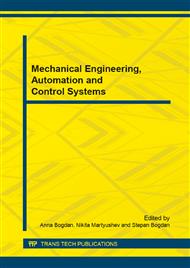[1]
V.F. Rasskazov, G.D. Ashmarin, A.N. Livada, Production of construction materials using technogenic wastes, J Glass and Ceramics. 66 [1-2] (2009) 3-4.
DOI: 10.1007/s10717-009-9109-7
Google Scholar
[2]
N.G. Gurov, L.V. Kotlyarova, N.N. Ivanov, Expanding the resource base of high quality wall ceramic production, J Construction materials. 4 (2007) 62-64.
Google Scholar
[3]
V.D. Kotlyar, A.V. Ustinov, V. Yu. Kovalev, Ceramic stones produced of flasks and coal enrichment wastes by means of compression molding, J Construction materials. 4 (2013) 44-46.
Google Scholar
[4]
V.A. Leshina, A.L. Pivnev, Ceramic Wall Materials Using Glass Waste, J Glass and Ceramics. 59 [9-10] (2002) 356-358.
DOI: 10.1023/a:1022090814669
Google Scholar
[5]
K.K. Chawla, Ceramic matrix composites, Springer, U.K., (2003).
Google Scholar
[6]
G. Storozhenko, A. Stolboushkin, Ceramic bricks from industrial waste, Ceramic & Sakhteman (Seasonal magazine of Ceramic & Building). 5 [Winter] (2010) 2-6.
Google Scholar
[7]
Malaiskiene J., Maciulaitis R., Frost Resistant Ceramics Produced from Local Raw Materials and Wastes, J Procedia Engineering. 57 (2013) 739-745.
DOI: 10.1016/j.proeng.2013.04.093
Google Scholar
[8]
Stolboushkin A. Yu., Improving decorative properties of ceramic wall materials produced of technogenic and natural resources, J Construction materials, 2013, 8: 24-29.
Google Scholar
[9]
A. Yu. Stolboushkin, G.I. Storozhenko, Needs and prospects of Kuzbass slimy iron ore wastes disposal in ceramic wall materials production technology, J Construction materials. 4 (2009) 77-80.
Google Scholar
[10]
A. Yu. Stolboushkin, Theory of formation of ceramic matrix composites made of technogenic and natural raw materials, J Construction materials. 2 (2011) 10-13.
Google Scholar
[11]
A. Yu. Stolboushkin, G.I. Storozhenko, A.I. Ivanov, G.I. Berdov and O.A. Stolboushkina, RU Patent 2, 500, 647. (2013).
Google Scholar
[12]
J. Williamson, A.J. Tipple, P.S. Rogers, The effect of vanadium oxides on the crystallization of silicate glasses, Journal of materials Science. 4.
Google Scholar
[12]
(1969) 1069-1074.
Google Scholar
[13]
A. Walter, R. Herber, C. Hess, T. Ressler, Structural characterization of vanadium oxide catalysts supported on nanostructured silica SBA-15 using X-ray absorption spectroscopy, Article published online: 11 February 2010 | DOI: 10. 1186/1752-153X-4-3.
DOI: 10.1186/1752-153x-4-3
Google Scholar
[14]
M.D. Herd, Ceramic matrix composites: components, preparation, microstructure & properties, J Materials and Manufacturing Processes. 8.
Google Scholar
[2]
(1993) 259-264.
Google Scholar
[15]
A. Yu. Stolboushkin, N.G. Romanov and V.F. Panova, RU Patent 2, 232, 735. (2002).
Google Scholar
[16]
A. Yu. Stolboushkin, G.I. Storozhenko, Coal wastes as raw material and energy base of wall ceramic plants, J Construction materials. 4 (2011) 41-46.
Google Scholar


